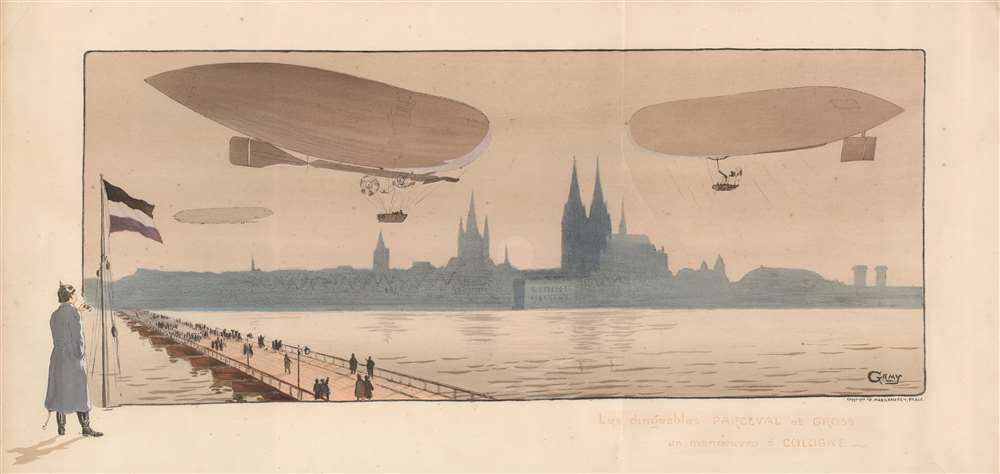1909 Gamy / Montaut View of the Dirigibles Parceval and Gross, Cologne, Germany
ParcevalGross-gamy-1909
Title
1909 (dated) 15.25 x 33 in (38.735 x 83.82 cm)
Description
The Parceval and the Gross
'Parceval' and 'Gross' were the names of the dirigible designers active in Germany in the first decades of the 20th century. August von Parseval (1861 - 1942), working with Luft-Fahrzeung-Gesellschaft produced twenty-two dirigibles between 1909 and 1919. 'Parsevals' were non-rigid or semi-rigid airships, meaning there was little to no stiffening structure within the fabric envelope. By contrast, Zeppelins, of which the most famous was the Hindenburg, had a rigid internal framework. The Parceval was likely the first airship built by Luft-Fahrzeung-Gesellschaft.'Gross' airships were semi-rigid airships constructed by Hans Georg Friedrich Gross (1880 - 1924) and Nikolaus Basenach. They constructed five airships (one experimental and four military) between 1907 and 1914, known as 'M-class German military airships'. It is likely that the airship illustrated here is M II.
Pochoir
Pochoir is an artistic printing process used in conjunction with other mediums, such as lithography, photography, or engraving. It begins with a découpeur, who studies the original piece meant to be reproduced, analyzing the range of colors. Then, stencils are generated (between eight and fifteen for basic works and more than forty for complex compositions) from materials such as copper, aluminum, or zinc. The stencils were then passed to coloristes who applied watercolors or gouache in layers. Given the idiosyncrasies of coloristes, even down to the strength of brush strokes, no two pochoirs are identical.Publication History and Census
This view was created by Marguerite 'Gamy' Montaut and published by Mabileau and Company in 1909. While this piece is not cataloged in OCLC and does not appear to be part of any institutional collections, it does appear on the market from time to time.Cartographer
Marguerite 'Gamy' Montaut (1883 - 1936) was a French artist who signed her work 'Gamy' and most of her work was produced using the pochoir process. She and her husband Ernest Montaut (1879 - 1909) created works of art focusing on the early transportation. Ernest Montaut began producing work in the early 1890s. Marguerite produced work focusing on not only auto racing but also early aviation. Marguerite is credited with the innovation of using lines behind vehicles to indicate speed, along with elongating parts of the vehicle to do so as well. She continued producing work after her husband's death in 1909. 'Gamy' is believed to be an anagram for 'Magy'. More by this mapmaker...

